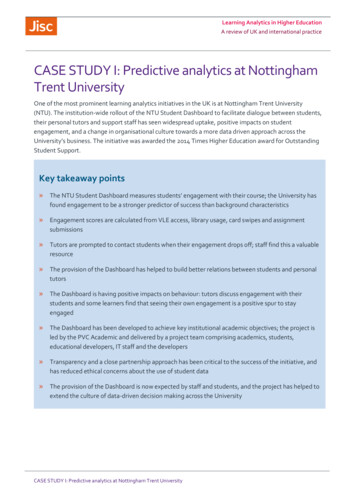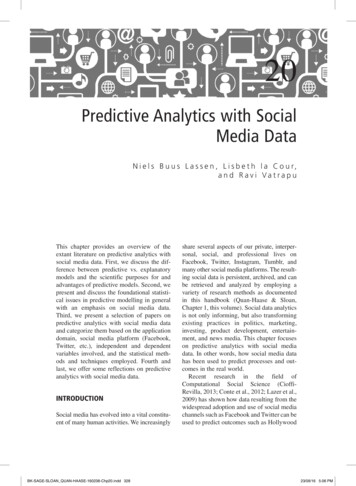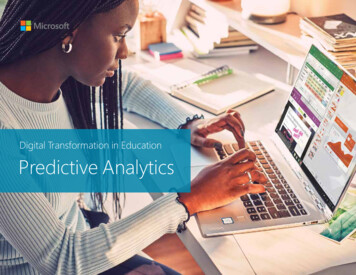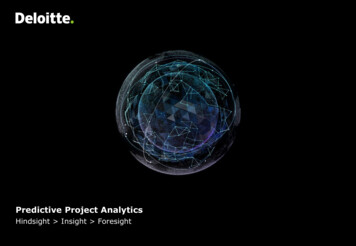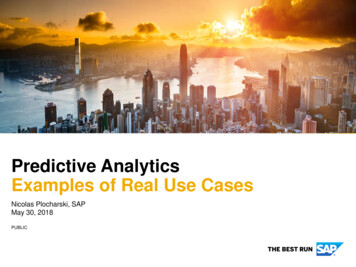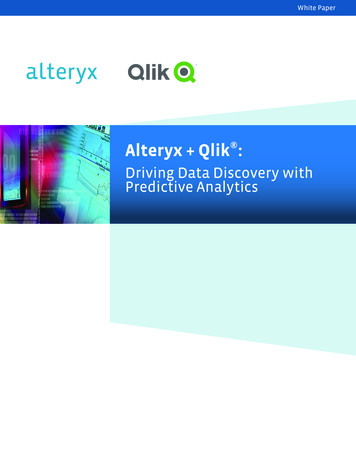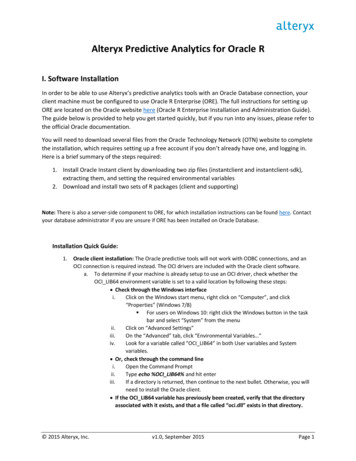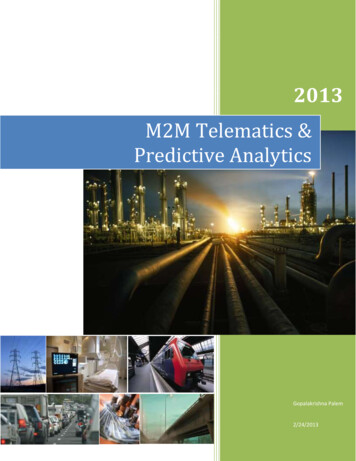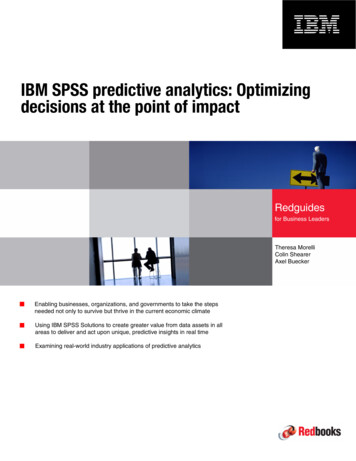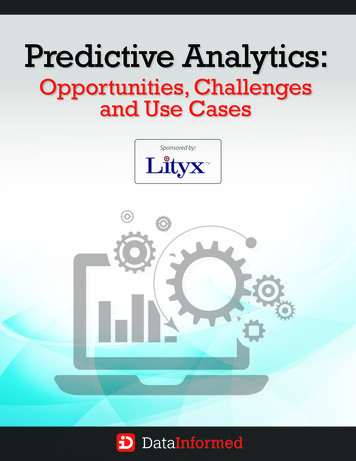
Transcription
Predictive Analytics:Opportunities, Challengesand Use CasesSponsored by:
Table of Contents:Page 3An Introduction to Predictive AnalyticsPage 8 Traditional BI and the Analytics ProgressionPage 14 Predictive Analytics & Big Data — A Real Power CouplePage 17 Ensemble Modeling: Get More Out of Your Predictive ModelingPage 21 Use Predictive Analytics to Improve the Customer ExperiencePage 24 Orlando Magic Applies Analytics to Retain Season Ticket HoldersPage 27 Use Behavioral Insights to Develop Better In-Store PromotionsPage 30 Use Predictive Modeling for Back-to-School Retail SuccessPage 33 Use Data-Driven Segmentation to Find Your Target AudiencePage 36 How to Get Sales Reps to Adopt and Crave Predictive AnalyticsPage 39 Translate Business Talk into Predictive Analytics ProjectsPage 41 Machine Data Worth a Pound of Cure for SystemsPage 44 How to Ensure Predictive Models Actually Work in the Business WorldPAGE 2
An Introduction toPredictive AnalyticsBy Eric SmalleyPeople have used computers to forecast aggregate behavior like that of markets foralmost as long as there have been computers. Making predictions about individuals is amuch more difficult matter. The focus of predictive analytics is rapidly shifting to gazingat—and betting on—the future of individuals.“It’s not forecasting how many ice cream cones you’re going to sell next quarter; it’swhich individual person is likely to be seen eating ice cream,” said Eric Siegel, author ofPredictive Analytics: The Power to Predict Who Will Click, Buy, Lie, or Die.Today’s analytics technologies and ample sources of data have made making predictionsabout probable individual behaviors and many other potential outcomes more practical.“Predictive analytics is, by definition, the most actionable form of analytics,” said Siegel.“Instead of just predicting the future, you can influence it.”A growing number of vendors, anchored by heavyweights IBM (through its acquisitionof SPSS in 2010) and SAS, supply predictive analytics software. The statistical analysisalgorithms these companies offer have been around for years, but two important elementshave changed how they are used. First, there’s a lot more data beyond traditional relationaldatabases with corporate data for the algorithms to use, among them weblogs trackingonline user behavior; the text, audio and video musings of millions; email messages; ITsystem data, such as application performance logs and security intrusions; and sensorsmeasuring location, time, temperature and wear on machines.The second change is technological. Distributed architectures have enabled Hadoop, anopen source software library, and NoSQL databases, a class of database managementsystems that do not use the relational database model, to attack very large datasets.These innovations and others, like in-memory databases, have ushered in a wave ofinnovation and a proliferation of use cases for predictive analytics.PAGE 3
An Introduction to Predictive AnalyticsUse CasesPredictive analytics is useful in any circumstance where you need to make a decisionbased on the likelihood of an individual unit of focus—like a person, retail outlet, orproduct—behaving in a certain way. Is Sam likely to buy the latest fashion? Is Juaninclined to vote Libertarian? Does Julie pose a risk to the community? Is WonderWidgetgoing to go viral? The potential applications are growing. Here are some snapshots:Marketing and sales. A marketing use case is churn modeling: identifying whichcustomers are likely to leave. This helps businesses target offers like heavy discountsor free phones that would be too expensive to offer in a less targeted way. Call centeroperations can identify the best response to a customer request or complaint toretain that customer and identify new opportunities for a sale. Another example:recommendation engines from social networks and e-commerce companies (thinkFacebook, Amazon, Netflix, and others) that make automated suggestions based onyour online behavior and that of customers making similar choices.Health care. Providing doctors with insights on how an individual’s condition comparesto that person’s history and the outcomes of other patients is one use case. For example,researchers at Memorial Sloan-Kettering Cancer Center are experimenting with IBManalytics to scan historical data about cancer case outcomes and assess patienttreatment options, with expectations that the system’s results will improve over time.Manufacturing. Predictive analytics has the potential to sharpen forecasts aboutcustomer demand by rapidly harvesting new data sources, thus making for moreefficient supply chains. Analytics applied to sensor data can detect the wear on factoryequipment, jet engines, and other mechanical devices, alerting operators aboutmaintenance or replacement needs.Human resources. By combining data about employee performance, personality testsabout worker potential, data from office applications about employee contributions,and traditional metrics about compensation, human resources executives are engagingin more sophisticated approaches to workforce management. Companies can projecttop performers among existing workers, and predict a job candidate’s suitability for arole like customer service or sales.Politics. A striking illustration of the power of predictive analytics comes from PresidentObama’s 2012 campaign. The re-election team used analytics to identify whichundecided voters were inclined to vote for Obama and then determined which ofthose could be persuaded by contact from the campaign as well as those who mightbe put off by contact. They also used analytics to decide how to campaign to individualvoters: whether to send a volunteer to the door, make a phone call, or send a brochure,said Siegel.PAGE 4
An Introduction to Predictive AnalyticsLaw enforcement. Another use case that has been getting attention is predictivepolicing. Rather than predicting when a person will commit a crime as in science fiction’s“Minority Report,” predictive policing identifies when a particular place is likely toexperience a rash of break-ins or other crimes. Los Angeles; Santa Cruz, Calif.; Memphis;and Charleston, S.C., have lowered their crime rates by using the technology to increasepatrols in the right places at the right times.The legal profession. Civil litigation, with its mountain ranges of text documents andother data, represents another ripe field, both for those seeking to avoid court and thosein court already. Lex Machina, a startup out of Stanford University, has developed atool to identify the risk of patent lawsuits in situations where executives are evaluatingcorporate acquisition targets. Meanwhile, in a legal dispute involving the sale of anational restaurant chain, a Delaware judge last year ordered the use of predictivecoding, a data analysis technique that would accelerate the process of identifyingrelevant documents, instead of using phalanxes of junior lawyers to do the work.Interestingly, not all use cases require accuracy. Predictive analytics can help directmarketing campaigns boost response rates. The technology doesn’t provide muchconfidence that any individual will make a purchase, but it can boost response ratesfrom, say, one percent to three percent, said Siegel. “That’s an example where it’s reallynot about accurate prediction; it’s about tipping the balance and playing the numbersgame better,” he said. “And you can make a dramatic improvement on the bottom line byplaying the numbers game better.”How Predictive Analytics WorksPredictive analytics is driven by machine-learning algorithms, principally decision trees,log linear regression, and neural networks. These algorithms perform pattern matching.They determine how closely new data matches a reference pattern. The algorithmsare trained on real data and then compute a predictive score for each individual theyanalyze. This way, the systems learn from an organization’s experience, said Siegel.The current trend is to use multiple predictive analytics models. Ensembles of modelsperform better than any individual model. “It turns out that if you have a bunch ofmodels come together and vote—anywhere between several and several thousand—you get the wisdom of the crowd of models; you get the collective intelligence of themodels,” said Siegel.PAGE 5
An Introduction to Predictive AnalyticsChallenges in ImplementationThe technology is innovative and the use cases have provoked a lot of interest—butmaking predictive analytics work in business is a challenging process that requires aserious assessment of an enterprise’s strategic goals, its appetite for investment, and awillingness to experiment.The first challenge in using predictive analytics is determining what technologyand level of resources to deploy. This requires assessing the size of the problem anorganization is trying to solve, said Omer Artun, CEO and Founder of AgilOne, a cloudbased predictive marketing analytics company.Projecting potential ROI is essential. For example, a large financial institution aiming toimprove performance in a multi-billion-dollar market by a few percentage points standsto gain several hundred million dollars, so it can afford to spend a couple of milliondollars a year on an analytics team and custom modeling, Artun said. Conversely, a retailcompany looking to improve sales by a few percentage points might stand to gain afew million dollars, and therefore should probably spend less than six figures and buy acommercial analytics package, he said.Other challenges in implementing predictive analytics are cultural and organizational,said Siegel. It’s important that the analytics are clearly connected to business goalsand are aligned with business processes, particularly when the technology introducesoperational changes. “It’s easy to make a model that’s cool and predicts well, but doesn’tnecessarily provide organizational value,” he said.That means figuring out how the results of predictive analytics fit into existing businessprocesses.Organizations need to avoid what Artun calls “the last mile problem.” Sometimes acompany will develop the right model and it will perform beautifully, but the resultsend up sitting in a file on a computer somewhere. The key is making sure results aredelivered to the point in a business process where decisions are made, he said. Peopledeveloping predictive analytics systems should take an API-first approach, meaningresults should flow from the model to the point of execution in a seamless and real-timeor near real-time manner, said Artun. “That makes a huge difference in the outcome.”These issues all point to the significance of the people who do the work. It’s alsoimportant for analytics teams to understand the business problems they’re tackling.Oftentimes, data scientists over-optimize or pay attention to the wrong aspects of abusiness problem, Artun said. “It’s an art and a science,” he said.PAGE 6
An Introduction to Predictive AnalyticsScott Nicholson, who left LinkedIn to become chief data scientist at Accretive Health,said in a recent presentation at a predictive analytics conference that it is particularlychallenging to find people, and that he looks to build a team with members from diversebackgrounds, such as biology, physics, computer science, and electrical engineering.They have to be familiar with analytical models, but possessing an investigative zeal ismore important.The right people are those “who think about problems and then are excited about goingout and finding data to answer questions,” he said. “This is not about algorithms. It’s notabout industries. It’s just about being curious about data.”With the continued spread of predictive analytics, it also pays to monitor publicperceptions of its applications. Privacy is a concern with predictive analytics becausedata drives accuracy and the focus is on individuals. The more you know aboutsomeone, the better you can predict his or her behavior. In 2012, these concernsprompted members of Congress and the Federal Trade Commission to ask questionsabout businesses’ use of consumer data, and policy debates are likely to continueboth in the United States and in other countries. There are also legal questions whenpredictive analytics play a role in police stops, sentencing, and parole decisions.From Prediction to PersuasionThe future of predictive analytics is persuasion. Organizations are beginning to tunetheir predictive analytics efforts to go beyond just assessing whether and how to takeaction. They are now also using their systems to predict whether their actions will havea significant impact. “There’s a difference between predicting behavior and predictingwhether you’ll influence that behavior, which is persuasion,” said Siegel.Persuasion analytics borrows the concept of a control group from medical research toassess action versus inaction. Persuasion is more difficult analytically than prediction,but it more directly informs decisions, Siegel said. Persuasion was the essence of theObama campaign’s highly successful analytics effort. Persuasion techniques are alsoused in targeted marketing, online ad selection, dynamic pricing, credit risk assessment,social services, and personalized medicine.Eric Smalley is a freelance writer in Boston. He is a regular contributor to Wired.com.Follow him on Twitter at @ericsmalley.PAGE 7
Traditional BI and theAnalytics ProgressionBy Scott EtkinTraditional business intelligence (BI) tools have served companies well for many years,explaining why events they were seeing in the market were taking place. But as theability to collect and store larger and larger amounts of data has grown, so has interestin using that data for much more than looking backward.The rise of big data means that advanced analytics is no longer the exclusive domainof statisticians and research scientists. Many organizations are advancing beyondtraditional BI, applying advanced analytics to their m
Predictive Analytics: The Power to Predict Who Will Click, Buy, Lie, or Die. Today’s analytics technologies and ample sources of data have made making predictions about probable individual behaviors and many other potential outcomes more practical. “Predictive analytics is, by definition, the most actionable form of analytics,” said Siegel.
